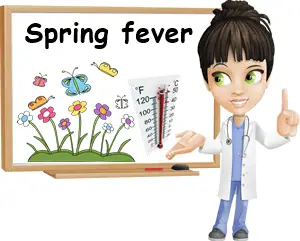Spring fever is a non-specific condition denominating a collection of mental and sometimes physical changes that accompany the end of winter and the beginning of spring. It is thought to be a reaction to warmer weather and can be explained as an adapting mechanism to temperature changes. The condition can be experienced either as a sudden and significant increase in vitality and energy accompanied by a feeling of restlessness and a wanting to spend time outdoors, or as unexplained fatigue, apathy, joint or muscle pain, sleepiness or bad mood.
What is spring fever?
Spring fever is the name given to a specific set of mental and sometimes physical changes that arise as a response to warmer weather. It is not recognized as a medical condition proper, nor it is a disease. The phenomenon debuts in early spring and symptoms may install during the first warm days. Despite the intensity of the symptoms reported by some, spring fever is not dangerous. It is, in some conceptions, considered a natural and thus normal response to seasonal changes such as warmer temperatures, longer days and, consequently, prolonged sunlight exposure, changes in eating or sleeping habits and so on.

Since I can remember, spring has always been difficult for me. And not because of pollen allergies, hay fever or because I would somehow love winter. Starting with the first warmer days of spring, I have always felt unusually tired, exhausted even and simply unmotivated, lethargic. But I noticed this was not the case for others who would experience a boost in energy and a visibly improved mood. As I researched the subject I found out that both my unexplained apathy and others’ surprising good mood were symptoms of spring fever.
Types of spring fever
Despite its rather unambiguous name, there are two quite different types of spring fever, each with its own set of symptoms:
- Spring fever characterized by unusual vitality and energy, complimented by a matching good disposition.
- Spring fever, springtime fatigue or spring lethargy, characterized by fatigue, apathy and even sadness.
Spring fever signs and symptoms
The symptoms of spring fever may include:
- Restlessness and a want to be active and out and about.
- Increase in energy levels.
- Increased vitality.
- Improved mood.
- A positive attitude and mindset.
- The desire to spend more time outside.
- Experiencing feelings of happiness.
The symptoms of spring fatigue, also called spring fever, may include:
- A drop in vitality.
- Apathy, lethargy.
- Lack of motivation.
- Low energy levels, tiredness, fatigue, exhaustion.
- Bad mood and a generally poor disposition.
- Irritability, agitation, hazy thinking or brain fog.
- Feeling sleepier.
- Experiencing feelings of sadness, anxiety or depression.
- Headaches, lightheadedness, dizziness.
- Muscle and joint aches and pain.
- Possibly also a runny nose or other cold-like symptoms.

What causes spring fever?
Spring fever symptoms are temporary. For most people, symptoms debut in April or May and may last up to June. As to what causes the condition, little is known with certainty. Out of all the factors that could possibly contribute to the onset of such a set of symptoms, the following theories have been advanced:
Pollen allergies or hay fever
Pollen allergies are very similar to springtime fever and share symptoms such as headaches, lightheadedness, low energy levels, tiredness or feeling sleepier than you normally are. Considering the ambiguity of the condition, it is possible that pollen allergies are a cause of spring fever just as it is possible for pollen allergies and spring fever to just share symptoms.
Changes in melatonin production
Spring means longer days and more daylight. This automatically engenders changes in the production of melatonin, the sleep hormone, causing us to sleep less since nights are getting shorter. It is this change that can put stress on our body and possibly cause spring fever-symptoms as our body balances its production of melatonin to suit shorter nights.
As we adjust to longer days and more daylight, we should normally start feeling better, more energized and positive. In some people, these other symptoms of spring fever occur instantly as a result of the seasonal changes, whereas in others they take time and effort.
Other hormonal changes
Our endocrine system is influenced by numerous factors, from season and temperatures to dietary habits, sleeping patterns, medication or nutritional deficiencies. Since springtime comes with so many changes not only warmer temperatures and longer days, but also changes in eating and sleeping habits, activity levels and so on, it has been suggested that our endocrine system adjusting to these changes may result in any of the various symptoms of spring fever.
Changes in blood pressure parameters
Some years spring debuts with surprisingly warm days. When temperatures are higher, blood vessels dilate which leads to lower than normal blood pressure numbers. If blood pressure is lower than usual, you may experience symptoms like an apparent drop in vitality, low energy levels, lethargy, lightheadedness, sleepiness and more. It may take some people a few days or a few weeks to adjust to warmer temperatures, while others may welcome the warmer weather happily.
Vitamin and mineral deficiencies
It fairly common for a lot of people to experience nutritional deficiencies. Some nutritional deficiencies are actually more likely during certain periods of the year. For example, summer time heat often causes mineral deficiencies such as magnesium deficiency. Wintertime comes with its own set of vitamin and minerals deficiencies, often vitamin C deficiency, vitamin D deficiency and even B vitamin deficiencies.
Plenty of people come out of winter with rather pronounced vitamin and mineral deficiencies. Because of the cold in wintertime, people tend to eat heavier foods, especially more meat, to get more calories which the body is requesting.
During wintertime, some people experience a drop in their intake of fresh fruit and vegetables, either because of lower availability or reduced selection, or because of increased prices. Whatever the reason, vitamin and mineral deficiencies do develop over winter. So when spring sets in with its warm and happier days and we start going out and about and generally being more active, our energy expenses increase and our body might feel the stress of adjustment a little too much because it requires more of certain nutrients to function optimally, hence the spring fever or spring fatigue symptoms.
Seasonal affective disorder (SAD)
Seasonal affective disorder is a form of seasonal depression that occurs mostly in winter, but has been found to occur in spring or summer as well. The condition is thought to be a result of poor or lack of exposure to sunlight due to shorter days, and believed to negatively impact the endocrine system, causing changes in the production of serotonin, melatonin and other hormones, changes that negatively impact mood and energy levels.
Seasonal affective disorder is characterized by lethargy, sleepiness, feeling tired or fatigued, having overall low energy levels, lack of motivation, bad mood, sadness, experiencing negative thoughts, a dark disposition or anxiety, many of which are also symptoms felt by people reporting spring fever.
Tips and solutions for spring fever
How to remedy spring fever?
If you’re experiencing an increase in energy levels and improved mood, then there is little to remedy and you probably don’t even want to change anything. But if what you are experiencing is springtime fatigue, then the following solutions can help improve symptoms and get you through spring:
Stay hydrated
Drink plenty of water to prevent dehydration and help the body produce mucus to expel irritant pollen particles from the respiratory system. Since allergies may be a reason why we are feeling particularly tired, sleepy and lethargic in spring, and dehydration may contribute to worsening the symptoms we may be experiencing, it is important to stay hydrated by drinking sufficient water. Herbal teas, fruit and veggie smoothies and fruit juices are also good juices to help keep you hydrated, but water should be your number one choice.
Avoid and manage contact with seasonal allergens
If you know you are allergic to pollen, it is important to wash your hair after being out, especially on particularly windy days, shower and change your clothes and avoid bringing shoes inside in case they might have gathered allergens while you were out. Change sheets at least once a week, and pillowcases every few days, and remember that pets can also bring plenty of pollen and other allergens inside the home.
Stick to a sleeping schedule
Although spring fever might come with insomnia or excessive sleepiness, it is important to find a balance by resting sufficiently and keeping to a schedule by sleeping and waking up at the same time every day. Say going to bed at 10 p.m. in the evening and waking up at 7 a.m. in the morning. Having a sleeping schedule is what helps me feel more rested and reduces my fatigue significantly when I deal with spring fever. Also see my 7 tips for better sleep at night.
Get your vitamin D
Come spring and sunny days, it’s important to enjoy sunlight exposure to replenish vitamin D reserves. Since we do get more sunlight in spring, it’s good for us to get some vitamin D to boost immunity and strengthen health. Also, exposure to natural light is, in itself, a great therapy for low mood and the side effects it generates.
Take dietary supplements
Take a multivitamin to make sure you start spring right. Although I take vitamins all year round, I find that starting on a good multivitamin a couple of weeks before spring sets helps reduce the severity of my spring fever symptoms and improves my mood, energy levels and productivity significantly. I also include more fresh fruits and vegetables into my diet.
Be active
Doing outdoor activities especially can help reduce stress, stimulate appetite, improve mood in general and encourage better physical and mental health. In my experience, the most difficult part is getting out of the house. After this, it does get easier.
Conclusion
I have suffered from spring fever for many years and struggled greatly with the mental changes it brings as well as the physical ones like lethargy, lack of motivation, excessive sleepiness, feeling tired, exhausted even all the time and always low on energy and sad. Not knowing what these symptoms meant was the most difficult for me because I didn’t know where to start making things better. Fortunately, even though my spring fever is not the happy type that comes with a boost in energy and a love for life greater than me, I can now manage my symptoms easily with simple solutions and remedies.
